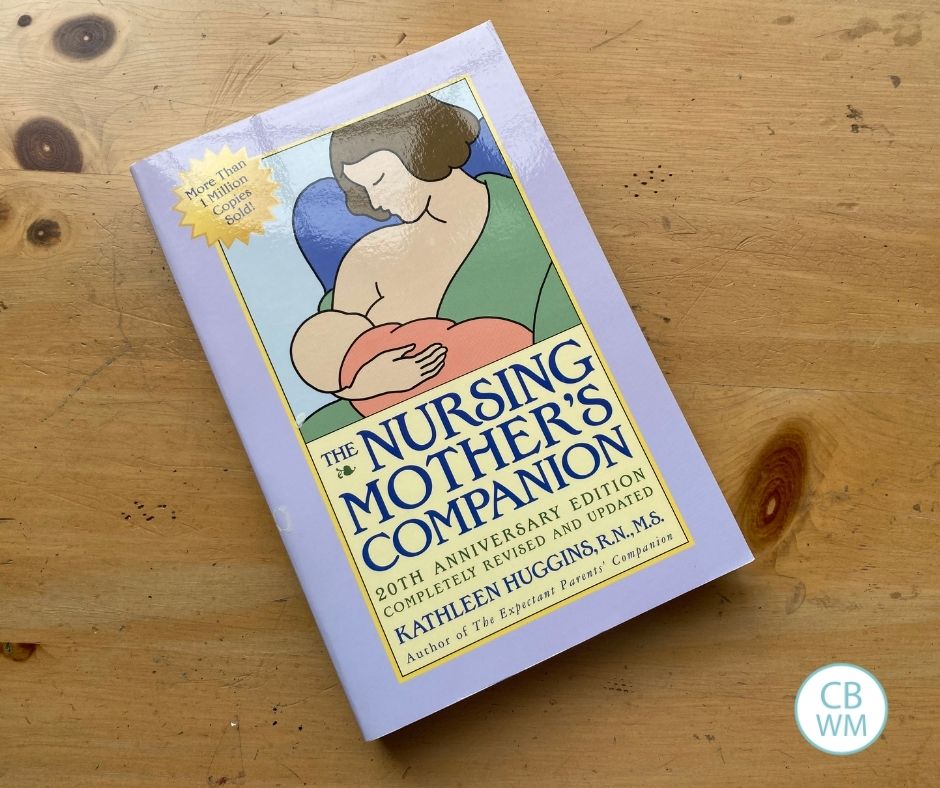A review of the book The Nursing Mother’s Companion. Find out if the book is helpful or not, especially if you are a Babywise Mom.

During my pregnancy with McKenna, my insurance company sent me The Nursing Mother’s Companion by Kathleen Huggins.
I didn’t really think it would come in handy for me to be perfectly honest. I had, after all, already nursed two children successfully for one year each. I had spent two of the last 3.5 years nursing a child.
While that doesn’t make me an expert, I thought I would have little need for a book dedicated to nursing. I didn’t have one while nursing my other two and made it just fine.
Post Contents
The Book is Informative
Well, I have found it to be helpful and informative. Yes, there is a lot in it that I don’t have need of (discussion of how to latch and different positions to hold), but I have found a lot of helpful information.
It is very complete, which isn’t surprising since the entire book is dedicated to nursing.
Sections in The Nursing Mother’s Companion
Here are some of the sections found in this book:
- Preparing for breastfeeding
- Ensuring milk supply
- Survival guides by week and later month
- Caring for breasts
- Breastfeeding difficulties
- Concerns about baby in various age groups
- Nursing adopted babies
- Relactation
- Nursing with thyroid issues (and other special circumstances)
- Nursing premature babies
- Nursing multiples
- Nursing babies with physical defects or neurological problems
- Nutritional needs
- Herbal supplements
- Nursing with illnesses and medications
- Breast infections
- Reflux, colic, etc.
- Pumping and storing milk
- Biting
- Weaning
- Nursing toddlers
- Nursing during pregnancy
- Tandem nursing
- Resource list for nursing mothers
- Charts for determining milk needs for babies birth to 6 weeks
Not Friendly Toward Schedules
While I have found this to be a helpful book, take note that it is a nursing book. As you might expect, it is not a book that is positive about schedules.
In fact, she has a section where she addresses Parent Directed Feedings, though she never says “Babywise.”
She said, “…the program teaches parents to feed babies on a rigid three to four-hour schedule and to eliminate nighttime feedings at an early age.
The purpose is to relieve parental anxiety and instill a sense of order and discipline in the infant…these practices are often associated with low milk production, poor weight gain in the baby, and early weaning. Some babies subjected to this method have become dangerously thin and dehydrated” (pages 126-127).
Perhaps there are other “Parent Directed Feeding” books out there?
If not, then she is referring directly to Babywise, and just plain wrong.
I actually read this section first as I flipped through the book. It irritated me so much that I put the book down.
I didn’t want to bother with it.
If she was that wrong about PDF, then how could I trust other things she said? However, I have found helpful information in the book.
>>>Read: Parent Directed Feeding (Babywise PDF) Explained
I want to address some of her points. First, PDF is not “rigid.” I feel like going through Babywise and counting the number of times it says to feed baby when baby is hungry no matter how long it has been. It says that a lot.
That is not rigid.
>>>Read: Babywise Instructs Parents to Feed Baby When Hungry
Also, it is not a four hour routine for a newborn. It is 2.5-3 hours.
Another point is that the parent doesn’t eliminate the nighttime feeding at an early age.
The infant does. If the infant doesn’t do it on her own, the parent will help eliminate it if the parent feels the child does not actually need the nighttime feeding anymore. This does not typically happen until the child is close to three months old.
The purpose of PDF is NOT “to relieve parental anxiety and instill a sense of order and discipline in the infant,” but rather to stabilize metabolism so the baby can eat at regular intervals and sleep at regular intervals.
Baby also then takes in full feedings each time she eats, getting plenty of hind milk if she is breastfeeding. Baby is then able to take a full nap, which helps brain synapses to form and helps baby to grow well. Baby is well rested and able to make the most of her waketime.
PDF is for the benefit of the baby. It also helps the rest of the family to add baby to the family, not revolve life around the family. Some parents might be fine revolving life around one child, but what do you do when you have more than one? Something has to give.
As far as “low milk production, poor weight gain in the baby, and early weaning,” all I can say is that I have never had a problem with any of those things. I have an entire post refuting this sentiment (see “related posts” section below).
Okay, now that I am done with my soapbox, despite the anti-PDF sentiment (it is only a few paragraphs), this book does have its helpful points and I find it valuable as a reference book to help with breastfeeding.

